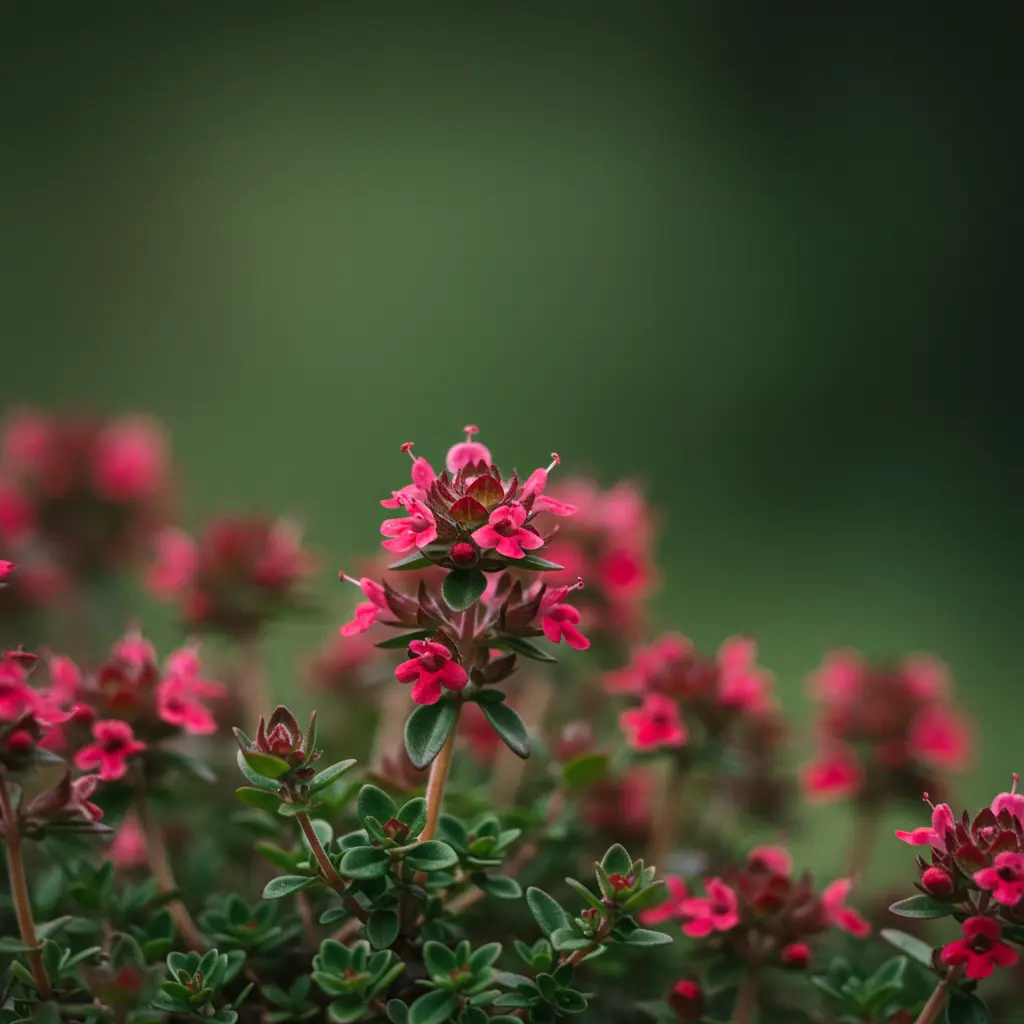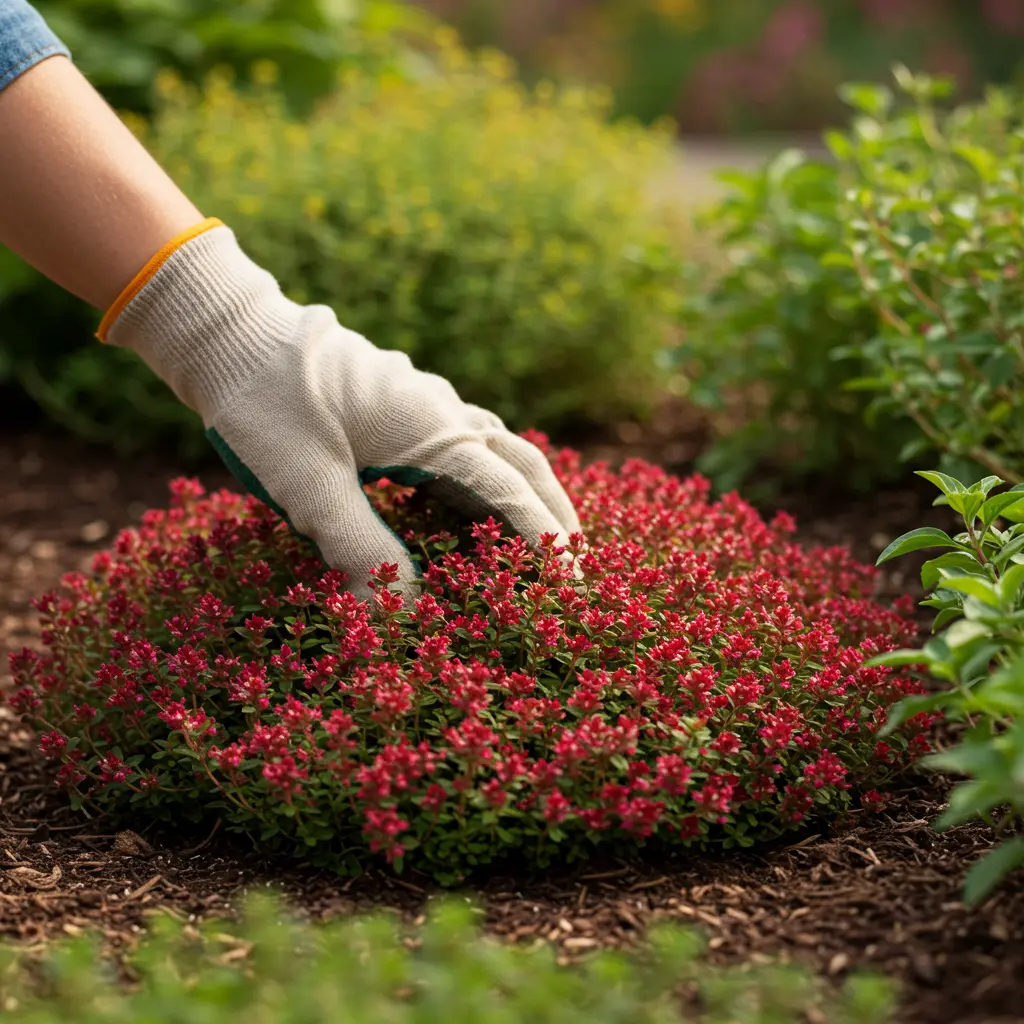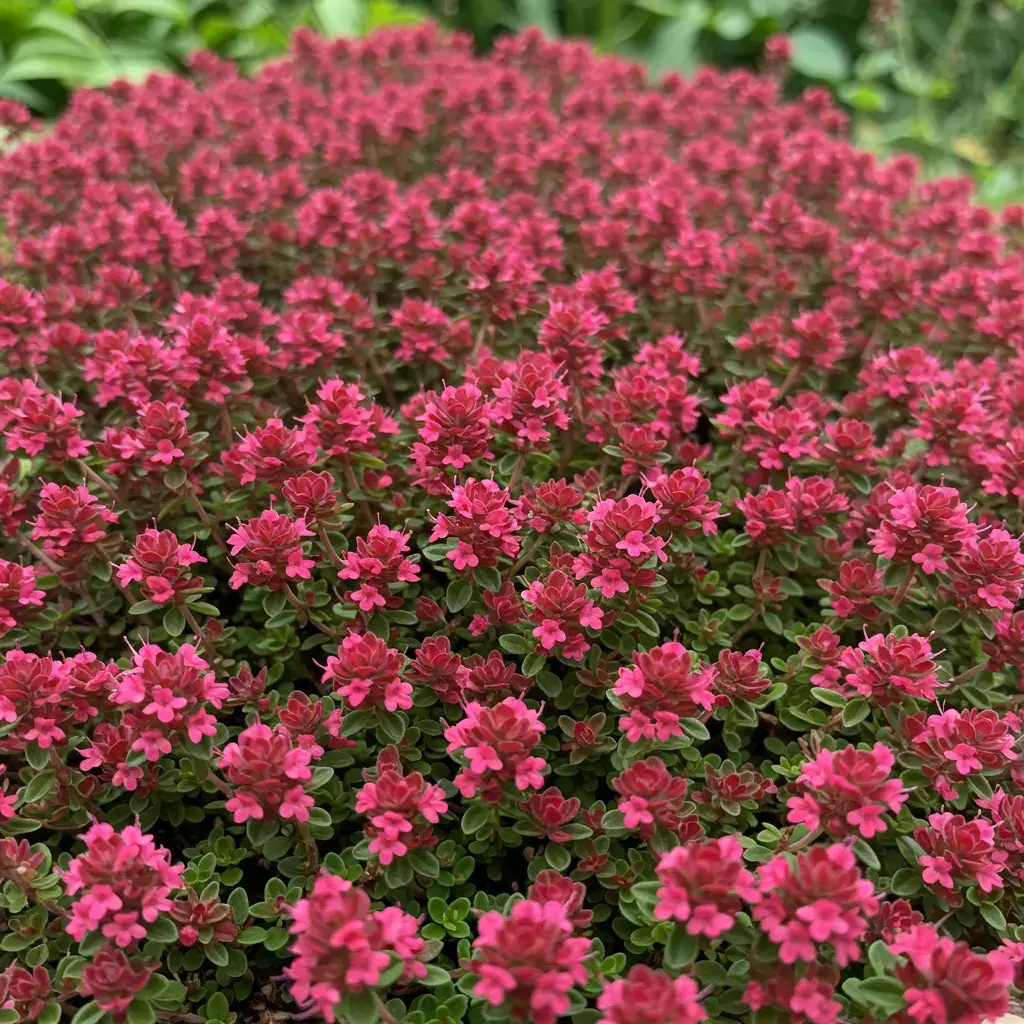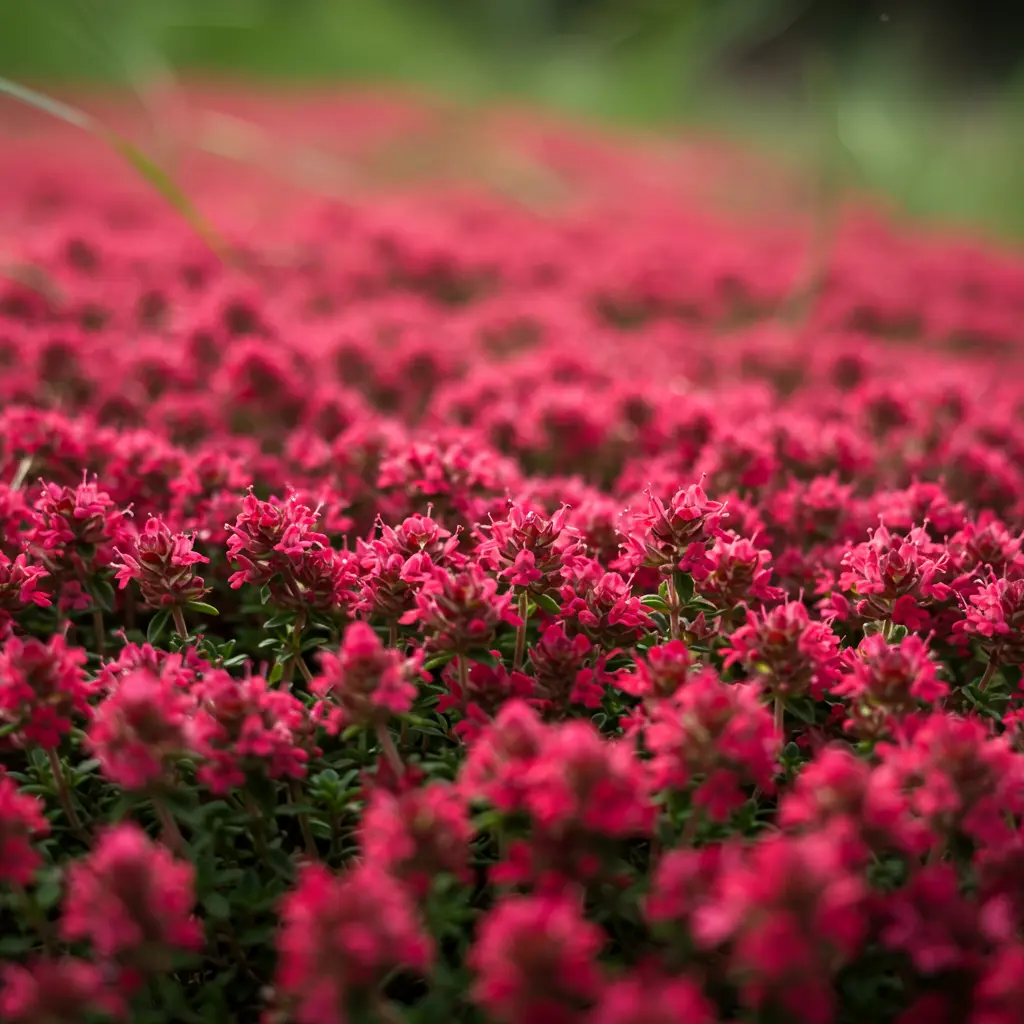Are you looking for a beautiful, low-maintenance ground cover for your garden? Red creeping thyme is the perfect solution—a vibrant, hardy plant that thrives with minimal care. This fragrant, flowering perennial forms a lush carpet of deep green foliage and stunning red-purple blooms, ideal for suppressing weeds and preventing soil erosion.
Drought-tolerant and versatile, red creeping thyme (Thymus praecox ‘Coccineus’) adapts to rocky paths, sunny slopes, and garden borders. Enjoy a low-upkeep landscape bursting with color and texture all season long!
Key Takeaways
- Red creeping thyme is a low-maintenance ground cover option.
- It’s suitable for various garden conditions.
- The plant is fragrant and produces flowers.
- It helps suppress weeds and prevent soil erosion.
- Red creeping thyme adds color and texture to your garden.
Understanding Red Creeping Thyme
As a perennial herb with a rich history in culinary and medicinal uses, red creeping thyme offers a unique combination of aesthetic appeal and practical benefits. To appreciate its value, it’s crucial to delve into its characteristics and growth patterns.
Botanical Characteristics
Red creeping thyme, a member of the Thymus genus, is characterized by its tiny, fragrant leaves and vibrant red flowers that bloom in early summer. It is a low-growing, mat-forming plant that can spread to cover large areas. Its botanical name, Thymus serpyllum, reflects its classification within the mint family.
Native Habitat and Growth Habits
Native to Europe and parts of Asia, red creeping thyme thrives in well-drained soils and full sun, making it an ideal choice for dry landscapes and rock gardens. It spreads through a combination of seed dispersal and vegetative layering, forming a dense mat that can suppress weeds. Some key growth habits include:
- Spreads quickly through underground stems
- Can form a dense mat, suppressing weed growth
- Requires minimal maintenance due to its hardy nature
Benefits of Red Creeping Thyme in Your Landscape

Red creeping thyme is a versatile, low-maintenance plant that offers numerous benefits for your outdoor space. By incorporating this plant into your landscape, you can enjoy a variety of advantages that enhance both the functionality and beauty of your garden.
Aesthetic Appeal
The vibrant purple flowers of red creeping thyme add a pop of color to your landscape, creating a visually appealing carpet of blooms during the summer months. Its dense, mat-like growth habit also provides a lush, weed-suppressing groundcover that can soften hardscapes and edges.
Practical Uses
Red creeping thyme is highly practical for filling gaps between pavers, stones, or other hardscaping elements, reducing the need for mulch or other weed-suppressing materials. It can also be used to create a fragrant, walking-surface alternative to traditional lawns.
Environmental Benefits
This drought-tolerant plant is an excellent choice for water-conscious landscaping. Additionally, its flowers attract pollinators like bees and butterflies, supporting local ecosystems and biodiversity. By choosing red creeping thyme, you’re opting for a sustainable, eco-friendly landscaping solution.
Ideal Growing Conditions for Red Creeping Thyme
Understanding the ideal growing conditions is crucial for the successful cultivation of red creeping thyme. This plant is known for its hardiness and adaptability, but like any plant, it thrives best under specific conditions.
Sunlight Requirements
Red creeping thyme requires full sun to partial shade. Ideally, it should receive at least 4-6 hours of direct sunlight per day. Full sun promotes healthy growth and flowering, making it an excellent choice for areas that receive ample sunlight.
Soil Preferences
This plant prefers well-drained soil and can tolerate a range of soil types, from sandy to rocky. Good drainage is crucial to prevent root rot. If you’re starting from creeping thyme seeds, ensure the soil is loose and drains well to support germination and early growth.
Climate Considerations
Red creeping thyme is relatively hardy and can adapt to various climates. Understanding its hardiness zone and temperature tolerance is key to its success.
USDA Hardiness Zones
It thrives in USDA Hardiness Zones 4-9. This range indicates its tolerance to different temperature extremes, making it suitable for a wide geographic area.
Temperature Tolerance
Red creeping thyme can tolerate temperatures as low as -30°F (-34°C) and as high as 75°F (24°C). This temperature tolerance makes it a versatile choice for different regions.
Planting Red Creeping Thyme
Whether you’re starting from seeds or transplanting mature plants, planting red creeping thyme requires careful consideration of several factors. This versatile and fragrant herb can thrive in a variety of conditions, making it an excellent choice for gardeners looking to add some color and texture to their landscape.
Starting from Seeds
Starting red creeping thyme from seeds can be a cost-effective way to cover large areas. To begin, you’ll need to acquire high-quality seeds.
Buying Creeping Thyme Seeds in Bulk
When buying creeping thyme seeds in bulk, ensure you’re purchasing from a reputable supplier to guarantee seed viability. This approach is particularly useful for large-scale planting projects.
Seed Starting Timeline
A typical seed starting timeline for red creeping thyme involves sowing seeds indoors 6-8 weeks before the last frost date in your area. This allows the seedlings to establish themselves before being transplanted outdoors.
Transplanting Established Plants
For a quicker establishment, you can transplant established red creeping thyme plants. This method is ideal for achieving immediate coverage.
Spacing and Layout Strategies
Proper spacing is crucial when planting red creeping thyme. For optimal coverage, plants should be spaced about 6-12 inches apart, depending on the desired density. Consider the mature spread of the plants when planning your layout to ensure a uniform appearance.
- Plant in well-draining soil to prevent waterlogged conditions.
- Ensure adequate sunlight for healthy growth.
- Water thoroughly after planting and during the establishment phase.
Essential Care for Red Creeping Thyme

Understanding the essential care needs of red creeping thyme is vital for its success in your landscape. To keep this beautiful, low-maintenance plant thriving, you need to provide it with the right conditions and care.
Watering Guidelines
Red creeping thyme requires careful watering to prevent overwatering, which can lead to root rot. Water your thyme plants lightly but frequently, making sure the soil is moist but not waterlogged. During hot summer months, you may need to water more often, but always check the soil moisture before watering.
Fertilization Needs
Fertilizing your red creeping thyme is not necessary, but it can promote healthy growth and flowering. If you choose to fertilize, use a balanced, water-soluble fertilizer during the growing season (spring and summer). You can also consider using organic fertilizers like compost tea. When purchasing thyme seeds in bulk, such as bulk creeping thyme seeds, it’s a good idea to start them in a well-draining seed mix with adequate nutrients.
Seasonal Care Tips
To keep your red creeping thyme healthy throughout the year, follow these seasonal care tips:
- In the spring, remove any dead or damaged foliage to promote new growth.
- During the summer, ensure the plants receive adequate moisture and sunlight.
- In the fall, cut back the plants to prepare them for winter.
- In the winter, protect the plants from extreme cold and moisture.
By following these care guidelines, you can enjoy a lush, thriving red creeping thyme in your garden.
Pruning and Controlling Your Red Creeping Thyme
Pruning is a crucial step in the care of red creeping thyme, ensuring it remains a lush, low-maintenance addition to your garden. Regular pruning not only maintains its desired shape but also encourages healthy growth and prevents the plant from becoming invasive.
When and How to Trim
The best time to prune your red creeping thyme is after it finishes blooming in the spring. Use a pair of sharp scissors or garden shears to trim back the plant, removing any dead or damaged stems. Cutting back the thyme by about one-third to one-half helps promote new growth and keeps the plant compact.
Managing Spread in the Garden
Red creeping thyme can spread quickly, so it’s essential to manage its growth to prevent it from overtaking other plants. Regularly inspect the boundaries of your thyme planting and trim back any stems that are encroaching on other areas. You can also use physical barriers, like edging stones or plastic barriers, to contain the spread if necessary.
By following these pruning and control tips, you can enjoy the beauty and benefits of your red creeping thyme without it becoming a nuisance.
Landscaping Ideas with Red Creeping Thyme
If you’re looking for a low-maintenance yet visually appealing ground cover, consider incorporating red creeping thyme into your landscaping design. This versatile plant can be used in various creative ways to enhance your garden’s beauty.
Between Stepping Stones and Pathways
Red creeping thyme is an excellent choice for planting between stepping stones and along pathways. As it grows, it softens the edges of the stones and creates a fragrant, lush carpet underfoot. To achieve this look, simply plant creeping thyme seeds or established plants between your pavers and enjoy the transformation.
Rock Gardens and Slopes
The hardy nature of red creeping thyme makes it an ideal candidate for rock gardens and slopes. It thrives in poor soil and can help stabilize slopes, preventing erosion. For a robust start, consider purchasing bulk creeping thyme seeds for larger areas.
Companion Plants
Red creeping thyme pairs well with a variety of plants, including sedum, delosperma, and other drought-tolerant species. When choosing companion plants, consider their growing conditions and ensure they complement the thyme’s needs. A well-planned combination can result in a stunning, low-maintenance landscape.
| Landscaping Idea | Benefits | Tips |
| Between Stepping Stones | Softens edges, fragrant | Plant creeping thyme seeds between pavers |
| Rock Gardens and Slopes | Thrives in poor soil, prevents erosion | Use bulk creeping thyme seeds for larger areas |
| Companion Plants | Low maintenance, visually appealing | Choose drought-tolerant species like sedum |
Enhance Your Outdoor Space with Red Creeping Thyme

As you’ve discovered, red creeping thyme is a versatile and low-maintenance ground cover that can elevate your garden’s aesthetic appeal. Its beautiful, fragrant blooms and ability to thrive in challenging conditions make it an ideal choice for various landscaping projects.
You can now envision your garden pathways lined with creeping thyme, softening the edges between stepping stones and releasing a pleasant aroma as you walk by. Whether you’re looking to create a lush, weed-suppressing mat or add a pop of color to your rock garden, red creeping thyme is a great option to consider.
By incorporating red creeping thyme into your landscape design, you’ll not only enhance the visual appeal of your outdoor space but also benefit from its environmental advantages, such as attracting pollinators and requiring less water. With proper care and maintenance, your red creeping thyme will flourish, providing a beautiful and functional ground cover for years to come.

